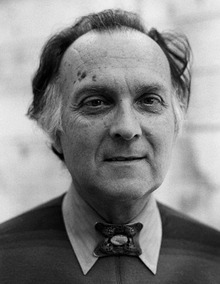Robert Duncan (poet) facts for kids
Robert Edward Duncan (born January 7, 1919 – died February 3, 1988) was an American poet. He spent most of his life in and around San Francisco. Duncan was connected to many literary groups, including the New American Poetry and Black Mountain College writers. He was a very important person in the San Francisco Renaissance, a time when many new artists and writers came together.
Contents
Who Was Robert Duncan?
Robert Duncan was not just a poet; he was also a public thinker. His ideas were important in many parts of popular culture. He was known in the bohemian communities of the 1930s and 1940s, which were groups of people who lived and thought differently. He also influenced the Beat Generation and the big cultural changes of the 1960s. Later in his life, Duncan's books were sold all over the world. His influence on poetry is still clear today in many kinds of writing.
His Early Life
Duncan was born in Oakland, California, as Edward Howard Duncan Jr. His mother died when he was born. In 1920, he was adopted by Edwin and Minnehaha Symmes. They were very religious followers of Theosophy, a belief system that explores spiritual wisdom. They renamed him Robert Edward Symmes. He later changed his name to Robert Edward Duncan in 1941.
A Special Childhood
His adopted parents had planned his arrival carefully. They believed he was meant to be born at a certain time and place, and that his mother would pass away soon after. He grew up in a stable home. His parents were popular in their community. Edwin was an architect, and Minnehaha volunteered a lot. Duncan was always aware of the special circumstances of his birth and adoption. His parents even helped him understand his dreams. The family adopted another child, Barbara, in 1920.
When he was three, Duncan had an accident that made him see double. He later wrote about this, saying he always had "the double reminder" in his vision. This experience later helped him see things in a unique way.
Learning and Growing
After his adopted father died in 1936, Duncan started studying at the University of California, Berkeley. He began writing poems that were inspired by his political beliefs. He became known as a bohemian, meaning someone who lives an unconventional, artistic life. He was a good storyteller and poet.
In 1938, he briefly attended Black Mountain College, a special school known for its arts. He left after a disagreement about the Spanish Civil War. He then lived in Philadelphia and later joined a community in Woodstock, New York. There, he worked on a magazine and met other famous writers.
Standing Up for Others
Robert Duncan was a brave voice for equality. In 1944, he wrote an important essay called The Homosexual in Society. In this essay, Duncan compared the struggles of people who were different to the struggles of African Americans and Jewish people. This essay was published in a journal called politics.
Duncan's essay was a very early and important paper about the experiences of people who were different in American society. It came out many years before the organized gay rights movement began. This made Duncan one of the first well-known Americans to openly share his personal identity. In 1951, Duncan met the artist Jess Collins. They became partners and worked together for 37 years, until Duncan's death.
Life in San Francisco
Duncan moved back to San Francisco in 1945. He became friends with other artists and writers. He went back to Berkeley to study Medieval and Renaissance literature. He became known as a special figure in the San Francisco poetry and art scene. His first book, Heavenly City Earthly City, was published in 1947. In the early 1950s, he started publishing in literary magazines. In 1956, he taught for a while at Black Mountain College.
His Important Books
In the 1960s, Duncan became very successful with three books: The Opening of the Field (1960), Roots and Branches (1969), and Bending the Bow (1968). These books are seen as his most important works. His poetry was modern and also romantic. It explored ideas about nature, feelings, and how language comes to be.
Here is a small part from one of his poems:
Neither our vices nor our virtues
further the poem. "They came up
and died
just like they do every year
on the rocks.
The poem
feeds upon thought, feeling, impulse,
to breed itself,
a spiritual urgency at the dark ladders leaping.
The Opening of the Field starts with a famous poem called "Often I Am Permitted to Return to a Meadow". This book has short poems, a series of prose poems (poems written like paragraphs) called "The Structure of Rime," and a long poem. The long poem uses ideas from many sources, like ancient Greek poets and other famous writers.
After his book Bending the Bow, Duncan decided not to publish new collections for fifteen years. He felt this would help him focus on his writing without distractions. His friend, the poet Michael Palmer, wrote about this time. Duncan's next major book, Ground Work I: Before the War, came out in 1984. He won an award for it. His last book, Ground Work II: In the Dark, was published in February 1988, the same month he passed away.
His Collected Works
The Collected Writings of Robert Duncan started to be published in 2011. There will be six books in total. These books will include his early and later poems, plays, and other writings.


